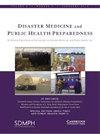灾害和人道主义环境下卫生资源分配经验证据差距图
IF 1.9
4区 医学
Q3 PUBLIC, ENVIRONMENTAL & OCCUPATIONAL HEALTH
引用次数: 0
摘要
目的 本综述旨在确定、评估并以图表形式展示与人道主义援助环境中稀缺医疗资源分配相关的文献空白。方法 在 MEDLINE(通过 Ovid)、Scopus、EMBASE、CINAHL Complete 和 ProQuest Central 中采用系统检索策略。文章由两名审稿人审阅,第三名审稿人负责纠正任何筛选冲突。对符合纳入标准的文章进行数据提取,以便对人道主义环境下卫生资源分配的经验证据的范围、性质和质量进行评估。最后,文章被映射到一个矩阵上,以图表的形式显示证据。结果 搜索策略确定了 6093 个单独的资料来源,在去除重复资料后,剩下 4000 个资料来源可供筛选。经过全文筛选,共纳入 12 篇资料。根据激增能力领域对提取的数据进行了映射,结果表明,所有 4 个领域都得到了反映,其中员工领域反映最多。大部分已确定的数据都没有遵循明确的结构或术语。最后,图谱显示,在人道主义响应环境中,临时增援能力的构建可能并不完整。结论 通过本次综述,我们发现了在应对与人道主义环境中稀缺资源分配相关的挑战方面存在的证据缺口。除了介绍现有文献的分布情况外,审查还证明了激增能力和资源分配原则的相关性,这些原则是所制定框架的基础。本文章由计算机程序翻译,如有差异,请以英文原文为准。
An Evidence Gap Map of Experience-based Evidence of Health Resource Allocation in Disaster and Humanitarian Settings
Objective The aim of this review is to identify, evaluate, and graphically display gaps in the literature related to scarce health resource allocation in humanitarian aid settings. Methods A systematic search strategy was utilized in MEDLINE (via Ovid), Scopus, EMBASE, CINAHL Complete, and ProQuest Central. Articles were reviewed by 2 reviewers with a third reviewer remedying any screening conflicts. Articles meeting inclusion criteria underwent data extraction to facilitate evaluation of the scope, nature, and quality of experience-based evidence for health resource allocation in humanitarian settings. Finally, articles were mapped on a matrix to display evidence graphically. Results The search strategy identified 6093 individual sources, leaving 4000 for screening after removal of duplicates. Following full-text screening, 12 sources were included. Mapping extracted data according to surge capacity domains demonstrated that all 4 domains were reflected most of all the staff domain. Much of the identified data was presented without adhering to a clear structure or nomenclature. Finally, the mapping suggested potential incompleteness of surge capacity constructs in humanitarian response settings. Conclusions Through this review, we identified a gap in evidence available to address challenges associated with scarce resource allocation in humanitarian settings. In addition to presenting the distribution of existing literature, the review demonstrated the relevance of surge capacity and resource allocation principles underpinning the developed framework.
求助全文
通过发布文献求助,成功后即可免费获取论文全文。
去求助
来源期刊

Disaster Medicine and Public Health Preparedness
PUBLIC, ENVIRONMENTAL & OCCUPATIONAL HEALTH-
CiteScore
4.40
自引率
7.40%
发文量
258
审稿时长
6-12 weeks
期刊介绍:
Disaster Medicine and Public Health Preparedness is the first comprehensive and authoritative journal emphasizing public health preparedness and disaster response for all health care and public health professionals globally. The journal seeks to translate science into practice and integrate medical and public health perspectives. With the events of September 11, the subsequent anthrax attacks, the tsunami in Indonesia, hurricane Katrina, SARS and the H1N1 Influenza Pandemic, all health care and public health professionals must be prepared to respond to emergency situations. In support of these pressing public health needs, Disaster Medicine and Public Health Preparedness is committed to the medical and public health communities who are the stewards of the health and security of citizens worldwide.
 求助内容:
求助内容: 应助结果提醒方式:
应助结果提醒方式:


